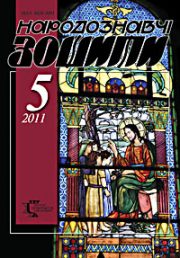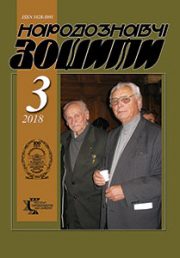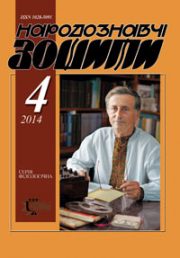The Ethnology Notebooks. 2021. № 6 (162), 1356—1366
UDK [392.1:398.3:140.8](=161.2):81’373.4’27
DOI https://doi.org/10.15407/nz2021.06.1356
«THE WORD WILL BREAK LIKE WATER» (ANALYSIS OF THE SEMANTIC PAIR «WATER-LANGUAGE»)
HOROSHKO-POHORETSKA Lesya
- ORCID ID: http://orcid.org/0000-0002-8741-2467
- Candidate of Historical Sciences (= Ph.D. in history),
- Senior Researcher at the Institute of Ethnology
- of the National Academy of Sciences of Ukraine
- Svobody Avenue, 15, Lviv, 79000, Ukraine,
- Contacts: e-mail: horoshyna@gmail.com
Abstract. The purpose of the exploration is to shed light on the layer of customary and ideological phenomena associated with the ritual and functionality of water in folk tradition. The object of the research is a traditional worldview, custom and ritual culture, folklore tradition of Ukrainians, and the subject — the semantic pair «water-language», that is those ritual contexts and linguistic units in which the concepts of «water» and «language» demonstrate semantic identity. In particular, the article discusses some ritual guidelines related to the rite of the first bath of the baby (using of unboiled water), and customary practices through which they tried to motivate children to speak faster (drinking water from a bell or water that has boiled), learn to read and write or play musical instruments by the river. In addition, a number of folklore and author’s texts, paremias and slang samples are analyzed, which illustrate the cohesion of the concepts «water-language», «drink-speak», etc., and samples of ancient writing of different peoples of the world, which were formed in climatic zones that differed in the amount of precipitation.
The source basis of the study is the materials of field investigations stored at the Ethnology Institute of the National Academy of Sciences of Ukraine (notes of L. Saban (1980) from Nadvirna district of Ivano-Frankivs’k region, H. Droniv (2012) from Bohorodchany and Kosiv districts of Ivano-Frankivs’k region, author (2005—2011) from Dolyna and Verkhovyna districts of Ivano-Frankivs’k region,Vyzhnytsia district of Chernivtsi region and Kaniv district of Cherkasy region), as well as works of the end of the XIX—XX centuries.
The methodology of the work is based on general scientific methodological principles and basic requirements that apply to the works of historical and ethnographic direction.
Keywords: water, language, speech, talk, river, waterfall, research.
Received 16.07.2021
REFERENCES
- Bartminski, J. (Ed.). (1999). Gloss of stereotypes and folk symbols(Vol. І: Kosmos). Lublin: Wydawnictwo Uniwersytetu Marii Curie-Sklodowskiej [in Polish].
- Pavlov, N.L. (2001). Altar. Mortar. Temple. Archaic universe in the architecture of the Indo-Europeans. Moscow: OLMA-PRESS [in Russian].
- Not that now Burkut: How the resort in the Carpathians dies, where Ivan Franko and Lesya Ukrainka were treated. Depo.ua. Retrieved from: https://if.depo.ua/ukr/prykarpattya/ne-toy-teper-burkut-yak-u-karpatakh-vmirae-kurort-de-likuvalisya-ivan-franko-i-lesya-ukrainka-202009061210885 (Last accessed: 25.09.2020).
- Arkushyn, G.L. (2000). Dictionary of West Polish dialects: in 2 vol. (Vol. 1: A—N). Lutsk: Editorial and publishing department «Tower» of Volyn’ State University of Lesya Ukrainka [in Ukrainian].
- Zakrevska, J. (Ed.). (1997). Hutsul dialects: a short dictionary. Lviv [in Ukrainian].
- Negrych, M. (2008). Treasures of the Hutsul dialect: Berezovy. Lviv: Institute of Ukrainian Studies of I. Krypjakevych of the National Academy of Sciences of Ukraine [in Ukrainian].
- Jaremenko, V., & Slipushko, O. (Eds.). (2006). New explanatory dictionary of the Ukrainian language: in 3 vol. (200000 words) (Vol. 1: A—K). Kyiv: Akonit [in Ukrainian].
- Jaremenko, V., & Slipushko, O. (Eds.). (2006). New explanatory dictionary of the Ukrainian language: in 3 vol. (200000 words) (Vol. 1: K—P). Kyiv: Akonit [in Ukrainian].
- Dubichynskyj, V. (Ed.). (2006). Modern explanatory dictionary of the Ukrainian language: 65000 words. Kharkiv: Shkola [in Ukrainian].
- Horoshko, L.M. (2008—2011). Calendar and family customs and rites in the villages of Nadvirna and Dolyna districts of Ivano-Frankivsk region, Vyzhnytsia and Kitsman’ districts of Chernivtsi region, Broby district of Lviv region, Turijsk and Ivanychi districts of Volyn’ region (field materials). Archive of the IN NANU. F. 1. Op. 2. Od. save 521. Arc. 1—103 [in Ukrainian].
- Droniv, H.M. (2012). Customs and rites in the villages of Bohorodchany district of Ivano-Frankivsk region (field materials). Archive of the IN NANU. F. 1. Op. 2. Od. save 654. Arc. 1—132 [in Ukrainian].
- Droniv, H.M. (2012). Customs and rites in the villages of Putyla district of Chernivtsi region (field materials). Archive of the IN NANU. F. 1. Op. 2. Od. save 656. Arc. 1—75 [in Ukrainian].
- Saban, L.S. (1980). Report on the expedition to the Hutsul`shchyna. Archive of the IN NANU. F. 1. Op. 2. Od. save 257 d. Arc. 50—73 [in Ukrainian].
- Makovij, H. (1997). People in national holidays. Chernivtsi: Fakel [in Ukrainian].
- (2000). Kolomijky from the village Verkhnia in the records of Mykola Klymyshyn. Lviv [in Ukrainian].
- Paziak, M.M. (Ed.). (1989). Proverbs and sayings. Nature. Human economic activity. Kyiv: Naukova dumka [in Ukrainian].
- Myshanych, S., & Paziak, M. (Eds.). (1983). Ukrainian proverbs and sayings. Kyiv: Dnipro [in Ukrainian].
- Dej, O. (Ed.). (1983). Folklore records of Marko Vovchok and Opanas Markovych. Kyiv: Naukova dumka [in Ukrainian].
- ViaGra: Каrаоке. Retrieved from: http://www.karaoke.ru/song/6583.htm (Last accessed: 10.03.2011).
- Laslo-Kutsiuk, M. (1992). Fire and word. Cosmogonic myth in Ukraine. Bucharest: Cryterion [in Ukrainian].
- Regional sports and tourist club. Retrieved from: http://www.tourclub.com.ua/uk/info/local-lore/other/prut_river (Last accessed: 15.10.2010).
- Oksana Bilozir’s personal website. Retrieved from: http://bilozir.com/index.php?option=com_content&task=view&id=351&Itemid=267 (Last accessed: 15.10.2010).
- Shekeryk-Donykiv, P. (2007). Dido Ivanchik: novel. Verkhovyna: Hutsul`shchyna region [in Ukrainian].
- Mandziak, A.S. (2007). Battle magic of the Slavs. Minsk: Harvest [in Russian].
- Nikitina, T.G. (2004). Youth slang: explanatory dictionary: more than 12000 words; over 3000 phraseological units. Moscow: Astrel [in Russian].
- Stavytska, L. (2003). A short dictionary of slang vocabulary of the Ukrainian language. Kyiv: Krytyka [in Ukrainian].
- 356 idioms. The meaning of idioms and their origin. Retrieved from: http://supermif.com/aforizm/fraz.html (Last accessed: 25.03.2019).
- Makovij, H. (1993). Trampled flower: ethnographic stories. Kyiv: Ukr. Pys`mennyk [in Ukrainian].
- An exhibition of unique photos of Shevchenko’s relative was opened in Kaniv (photo). Native Cherkashchyna. Retrieved from: https://ck.ridna.ua/2016/05/20/u-kanevi-vidkryly-vystavku-unikalnyh-svitlyn-rodycha-shevchenka-foto/ (Last accessed: 14.05.2021).
- Droniv, H.M. (2012). Customs and rites in the villages of Kosiv district of Ivano-Frankivsk region (field materials). Archive of the IN NANU. F. 1. Op. 2. Od. save 659. Arc. 1—186 [in Ukrainian].
- Medieval torture for women. Terrible tortures and executions of the Middle Ages. Rabota youth. Retrieved from: https://rabotayouth.ru/uk/srednevekovye-pytki-dlya-zhenshchin-uzhasnye-pytki-i-kazni-srednevekovya.html (Last accessed: 14.05.2021).
- Nalyvajko, S.I. (2007). Ukrainian Indo-Arica. Kyiv: Jevshan-zillia [in Ukrainian].
- Kipu. Retrieved from: https://uk.wikipedia.org/wiki/%D0% 9A%D1%96%D0%BF%D1%83 (Last accessed: 7.05. 2021).
- Kipu — nodular type of the Incas. Historical and patriotic club «Alatyr». Retrieved from: https://www.alatyr-history.club/?p=2784 (Last accessed: 7.05.2021).
- Culture of Ancient China. All-Ukrainian electronic encyclopedia. Retrieved from: https://xn—-7sbnbacaxoeehuadkjsh3b6fzj4f.xn--j1amh/history/kultura-davnogo-kitaju.html (Last accessed: 7.05.2021).
- Biblical Hebrew. Center for Scientists and Teachers of Jewish Studies in Universities «Sefer». Retrieved from: https://sefer.ru/rus/education/educational_programmes/bibleiskii_ivrit.php (Last accessed: 7.05.2021).
- Arabic type. Paratype. Retrieved from: https://rus.paratype.ru/arabic-3156595d-9076-49dc-877a-8d5f61841984 (Last accessed: 7.05.2021).
- Aramaic type. Its features and branches. Retrieved from: https://ukr.agromassidayu.com/aramejskoe-pismo-ego-osobennosti-i-otvetvleniya-view-594873#menu-4 (Last accessed: 14.05.2021).
- Shukhevych, V.O. (1999). Hutsul`shchyna (Vol. IV). Verkhovyna: Hutsul`shchyna [in Ukrainian].
- Horoshko-Pohoretska, L.M. (2015). Field materials from Hutsul`shchyna (Nadvirna, Verkhovyna districts of Ivano-Frankivsk region). Archive of the IN NANU. F. 1. Op. 2. Od. save 778. Arc. 1—69 [in Ukrainian].
- Hajova, J. (2011). Philosophy of life in Lemko winter rites and customs (Christmas, Basil, «Babyn Sviatyj Vechur», John the Baptist, Stritennia Hospodnie) on expedition materials collected in the Velykyj Bereznyj districts of Transcarpathian region. In Calendar rituals in the life of the ethnos: materials of the international scientific conference «Odessa ethnographic readings». Odessa: KP OMD [in Ukrainian].
- Korol, V. (2018). Ethnographic notes from the Transcarpathian Hutsul`shchyna (Vol. IV). in the records of H. Strypskyj. In Ethnic Carpathians: scientific yearbook: art. and materials of ethnographic expeditions (Issue 3, pp. 182—194). Uzhhorod: Publishing House of Oleksandra Harkusha [in Ukrainian].
- Mojsej, A. (2008). Magic and mantica in the folk calendar of the Eastern Romanesque population of Bukovyna. Chernivtsi: Druk Art [in Ukrainian].
- Kabakova, G., & Sedakova, I. (Eds.). (2004). Baby. In Tolstoj, N.I. (Ed.). Slavic antiquities: ethnolinguistic dictionary: in 5 vol. (Vol. 3: K (Circle) —P (Quail), pp. 257—264). Moscow: Mezhdunarodnyje otnoshenija [in Russian].
- Toporkov, A. (2004). Spoon. In Tolstoj, N.I. (Ed.) Slavic antiquities: ethnolinguistic dictionary: in 5 vol. (Vol. 3: K (Circle) — P (Quail), pp. 129—134). Moscow: Mezhdunarodnyje otnoshenija [in Russian].
- Kolessa, F. (1898). People’s beliefs in Pidhirja, in the village Khodovychi Stryi District. In Etnohrafichnyj zbirnyk (Vol. V, pp. 76—98). Lviv [in Ukrainian].
- Bugera, I. (1939). Customs and beliefs of Lemko. Lviv: Nash Lemko [in Ukrainian].
- Horoshko, L.M. (2005). Calendar and family customs and rites in the villages of Skole and Turka districts of Lviv region, Verkhovyna district of Ivano-Frankivsk region, Vyzhnytsia and Putyla districts of Chernivtsi region, Rakhiv and Velykyj Bereznyj districts of Transcarpathian region (field materials). Archive of the IN NANU. F. 1. Op. 2. Od. save 533. Arc. 1—183 [in Ukrainian].
- Varkhol, N. (1995). Folk methods of prevention and treatment of childhood diseases. In Scientific collection of the State Museum of Ukrainian Culture in Svydnyk (Issue 20, pp. 239—258). Priashiv [in Ukrainian].
- Horoshko, L.M. (2009). Calendar and family customs and rites in the villages of Kaniv district of Cherkasy region (field materials). Archive of the IN NANU. F. 1. Op. 2. Od. save 594. Arc. 1—143 [in Ukrainian].
- Hrushevskyj, M., & Kuzelia, Z. (Eds.). (1906). The child in the customs and beliefs of the Ukrainian people. Materials from the Southern Kyivshchyna. In Materialy do ukrajins`ko-rus`koji etnoliogiji (Vol. VIII, pp. 1—220). Lviv [in Ukrainian].
- Zakharchenko, S. (2009). Traditional elements of maternity rites and their transformation in the 50—60’s of the twentieth century (on the materials of Perejaslavshchyna). In Pereyaslavica: scientific notes of the National Historical and Ethnographic Reserve «Pereyaslav» (Issue 3 (5), pp. 124—128) [in Ukrainian].
- Kabakova, G.I. (2001). Anthropology of the female body in the Slavic tradition. Moscow: Ladomir [in Russian].
- Sedakova, I.A. (2004). Bathing the baby. In Tolstoj, N.I. (Ed.) Slavic antiquities: ethnolinguistic dictionary: in 5 vol. (Vol. 3: K (Circle) — P (Quail), pp. 51—54). Moscow: Mezhdunarodnyje otnoshenija [in Russian].
- Shkarban, A. (1999). Materials on folk medicine of Zhytomyr Polissia. Polissia of Ukraine: materials of historical and ethnographic research (Issue 2, Ovruchchyna. 1994, pp. 211—224). Lviv: IN NANU [in Ukrainian].
- Yashchurzhynskyj, K. (1893, july). Beliefs and rituals of birth and christenings. Kijevskaja starina. (Issue 12, pp. 74—83) [in Russian].






